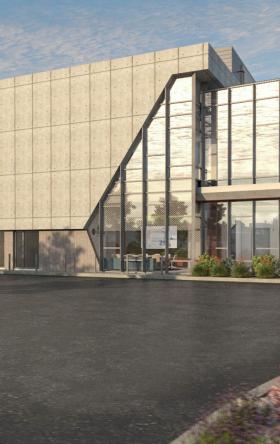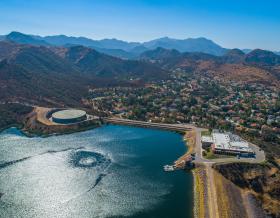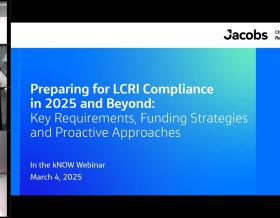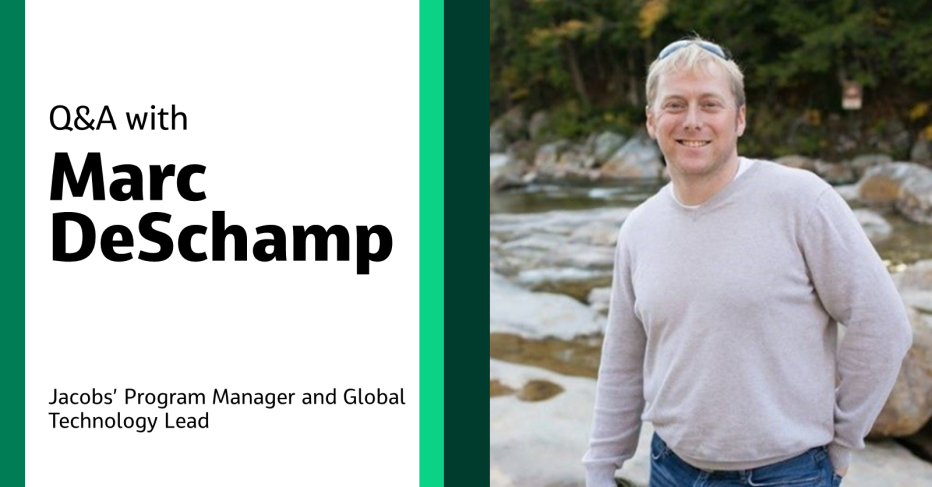
As the transportation industry moves toward decarbonization, how should transit agencies be planning ahead as they seek to electrify their fleets? We sat down with Marc DeSchamp, Green Fleets Program Manager and Global Technology Lead for bus transit at Jacobs to discuss the challenges transit agencies face and how Jacobs can help them successfully electrify their fleets.
Can you explain your role with Jacobs?
A little background – I’ve been at Jacobs for 13 years. I have a background in the vehicles and transit space, which over the years led me to opportunities around strategic planning and facilities in the fleet space, which ultimately led to an opportunity at Jacobs managing a program for the Massachusetts Bay Transportation Authority (MBTA). That program was to modernize and electrify their network of bus maintenance facilities, and I saw an opportunity for Jacobs to move forward in the green fleet space. Now, I help clients do just that.
In addition to my client-facing responsibilities, I wear two other hats. One is Global Technology Lead for bus transit, in which I support communication and collaboration between Jacobs staff working on bus projects across the globe - vehicles, facilities, planning, electrification and more. The other is Green Fleets initiative leader, in which I’ve helped develop a Jacobs solution to decarbonization for transit clients.
What’s the difference between transportation and transit?
Transit usually refers to public transportation – think city buses and trains. Transportation is a broader umbrella. Transit falls under transportation, but not the other way around.
Why do you think decarbonization efforts have been limited thus far - for example, limited to electric vehicle acquisition rather than planning and management?
There are a few reasons why electrification of transit hasn’t gone further than it has. Transit agencies have been providing service for a long time, primarily through diesel, compressed natural gas or more recently, hybrid vehicles. Of course, there are downsides to using fossil fuels to deliver goods, people and services, but the current system and technology has been in place for more than a hundred years. You’re talking about taking much of the technology and infrastructure developed over the last century and phasing it out. That involves significant capital investment, operational impact, and risk to communities.
First, regarding investment: The long-term benefits of this new technology are sometimes less tangible to governments than the more immediate dollars and cents that it will take to get there. It can be hard for transit agencies to compete for short-term funding.
Second, on operational impact and risk: Switching to electric is a significant disruption. No one gets out of bed in the morning and says, “I want to engage in this really risky disruption to my service.” They are taking on risk by engaging in early adoption of a technology that’s different from what they’re used to in their daily operations.
Lastly, like with any new or emerging technology, the vehicles themselves and technology continue to evolve. Whether it’s the vehicles, charging equipment, infrastructure or utilities – all of that takes funding and time for the technology to mature and develop. However, change is important – reducing greenhouse gases, pollutants and noise all have significant positive impacts on the communities these transit agencies serve.
What are some of the broader applications of green transportation that we don’t usually think about?
We see lots of services on the roads right now – transit is one, but think about school bus fleets, garbage truck fleets, delivery fleets, paratransit (community transportation), services for disabled or senior citizens, ambulatory services. There are also vehicles at ports, railroads, airports, material-handling equipment – not necessarily the plane or locomotive, but all the other vehicles on those types of campuses. Then there’s long-haul trucking and passenger autos. Those categories cover most of the transportation sector and each has its own part to contribute to the decarbonization of the transportation sector.
Why is Jacobs uniquely set up for successful at helping clients tackle these challenges?
Transportation and decarbonization touch a lot of different areas: Planning, power and utilities engagement, facilities modernization and redesign, procuring vehicles, sustainability and equity, financing, program management.
Jacobs has specialists working in all those areas. The issue isn’t about how we address any one of these alone, but how we best mobilize our resources to address all those areas in concert. Our clients are focused on serving their customers; tackling a huge multi-disciplinary program like electrifying their fleet is a huge diversion from their daily operations. A company like Jacobs, which can bring it all together, is exactly what they need to deliver results.
How is Jacobs thinking differently about the way it engages with clients on their decarbonization efforts?
One thing that sets us apart is that we do operations and maintenance. Jacobs owns around 2,500 vehicles to support programs and client needs, often directly operating those fleets to provide service to a community. It’s a whole business line that we offer, for example, to airports and municipalities. So, we’re not only consultants, engineers or architects – we understand operations and maintenance to provide services, just like our clients do, so we understand their challenges and concerns as they look at decarbonization.
How have you seen long-term clients evolve over the years in this area? What are they trying to do next?
Many of our clients are in the same or similar space. Some were early adopters, using grant money to get pilot projects on the streets, while others were less bullish. They’ve all dipped their toes in the water in one way or another but are now under more aggressive pressure to move forward and are all trying to figure out the best way to do so. We’re starting to see many of them put out planning studies or program contacts. They’re recognizing the urgency to move forward now but are still moving forward methodically with a monstrous undertaking.
What recent projects are you particularly proud of or excited about?
In the beginning of our program with MBTA, the agency started out saying they weren’t ready for electrification – they would modernize their facility network but weren’t sure when the technology would be ready for their challenging, cold-weather environment. We helped them realize that some of their garages were quite compatible with battery-electric buses (BEBs) and that they could meet their existing service needs with BEBs. They looked at the data and adjusted course, even changing the direction of a garage project that was partially designed to include more electric buses on day one. Helping this key client see a path to electrifying their fleet and start moving down it was a proud moment with our team.
What is the most fulfilling part of your career and your work?
For me, it’s about making connections. It’s taking a firm like Jacobs, looking at all the things we do, and realizing that we can be more than the sum of our parts. I can talk to a supermarket logistics specialist one day, garbage truck fleet operators another day, and then transit folks and utility providers the next day – you realize just how decarbonization is affecting everyone.
Tell us something about yourself that we didn’t know.
I love travel, ice hockey (even though my joints creak now), skating with my two young kids – we built an outdoor ice rink this past winter!
Join #OurJacobs team
What drives you drives us as we work to build a better world – together. At Jacobs, every day is an opportunity to make the world better, more connected, more sustainable.
We’re always looking for dynamic and engaged people to join our team. Bring your passion, your ingenuity and your vision.
You might be interested in...
-
 Showcase
ShowcaseMeet Marc DeSchamp
For Marc DeSchamp, it’s about making connections. It’s taking a firm such as Jacobs, looking at all the things we do, and realizing we can be more than the sum of our parts. After all, transportation and decarbonization touch a lot of different areas — planning, power and utilities engagement, facilities modernization and redesign, procuring vehicles, sustainability and equity, financing, and program management. And Jacobs has expertise in all those areas.
-
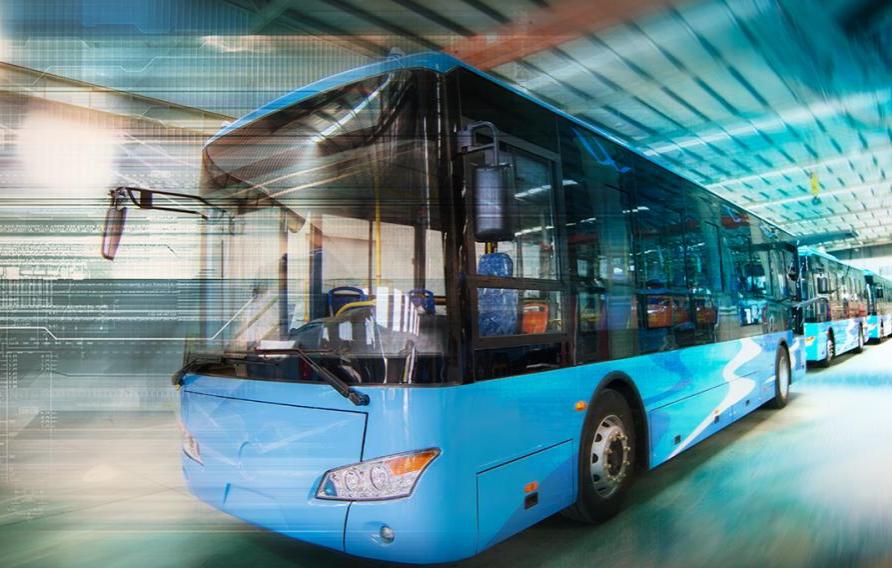 Page
PageGreen Fleets
Reducing global transportation sector emissions is a top priority, and the greening of public and private vehicle fleets is one way for entire populations to take steps towards reducing their carbon footprint and environmental impacts.


